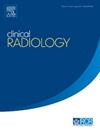高危乳腺癌MRI筛查:局部评分系统的诊断性能
IF 2.1
3区 医学
Q2 RADIOLOGY, NUCLEAR MEDICINE & MEDICAL IMAGING
引用次数: 0
摘要
AimBreast MRI被广泛用于高风险女性的筛查,尽管它的高成本和假阳性率带来了挑战。越来越多的研究正在探索将乳房MRI整合到其他患者群体的筛查中,包括乳房致密和/或乳腺癌终生风险中等的女性。我们评估了莱斯特评分系统(LSS)在管理高风险筛查乳腺MRI中发现的病变的诊断性能。材料与方法本研究回顾性分析了10年间(2014-2024年)174例高危乳腺MRI检查中的73个病变。病变包括肿块、病灶和线状/导管非肿块样强化。使用LSS对病变进行分类和评分,LSS结合了五种MRI描述符:边缘、信号模式、内部增强、对比动力学和DWI模式。结果10例恶性病变LSS评分均≥2分(平均4.6分)。在40个良性病变(不包括IMLNs)中,87.5%的病变评分为<;2(平均值:1.1)。最佳临界值为2,灵敏度为100%,特异性为87.5% (p<0.001)。典型的IMLNs在影像学上常常表现为恶性肿瘤,当它们的大小标准不显著时,应排除在评分之外,并视为良性。使用LSS可以潜在地避免48%的病变活检,如果排除imml,则可以避免高达79%的病变活检,而不会遗漏任何癌症。读者间一致性非常好,k值为0.81 (p<0.001)。结论莱斯特评分系统有可能在不影响癌症检测的情况下避免高达79%的不必要的活检。我们的结果挑战了在这组女性中癌症可能只表现为良性特征的假设。本文章由计算机程序翻译,如有差异,请以英文原文为准。
High-risk breast cancer screening with MRI: diagnostic performance of a local scoring system
Aim
Breast MRI is widely used for screening high-risk women, though its high cost and false positive rates pose challenges. There is growing research exploring the potential integration of breast MRI into the screening of other patient groups, including women with dense breasts and/or an intermediate lifetime risk for breast cancer. We evaluated the diagnostic performance of Leicester scoring system (LSS) in managing lesions detected at high-risk screening breast MRI.
Materials and Methods
In this retrospective study, 73 lesions from 174 high-risk breast MRI studies over a 10-year period (2014–2024) were analyzed. Included lesions were masses, foci, and linear/ductal non–mass-like enhancement. Lesions were classified and scored using the LSS, which combines five MRI descriptors: margins, signal patterns, internal enhancement, contrast kinetics, and DWI patterns.
Results
All 10 malignant lesions had LSS scores ≥2 (mean: 4.6). Of the 40 benign lesions (excluding IMLNs), 87.5% had scores <2 (mean: 1.1). The optimal cut-off of 2 achieved 100% sensitivity and 87.5% specificity (p<0.001). Typical IMLNs, which often mimic malignancy on imaging, should be excluded from scoring and considered benign when they are not significant by size criteria. Using LSS could potentially avoid biopsy in 48% of lesions, or up to 79% if IMLNs are excluded, without missing any cancers. The inter-reader agreement was very good, with a K-value of 0.81 (p<0.001).
Conclusion
Leicester Scoring System has the potential to avoid up to 79% of unnecessary biopsies without compromising cancer detection. Our results challenge the assumption that cancers may present with exclusively benign features in this cohort of women.
求助全文
通过发布文献求助,成功后即可免费获取论文全文。
去求助
来源期刊

Clinical radiology
医学-核医学
CiteScore
4.70
自引率
3.80%
发文量
528
审稿时长
76 days
期刊介绍:
Clinical Radiology is published by Elsevier on behalf of The Royal College of Radiologists. Clinical Radiology is an International Journal bringing you original research, editorials and review articles on all aspects of diagnostic imaging, including:
• Computed tomography
• Magnetic resonance imaging
• Ultrasonography
• Digital radiology
• Interventional radiology
• Radiography
• Nuclear medicine
Papers on radiological protection, quality assurance, audit in radiology and matters relating to radiological training and education are also included. In addition, each issue contains correspondence, book reviews and notices of forthcoming events.
 求助内容:
求助内容: 应助结果提醒方式:
应助结果提醒方式:


